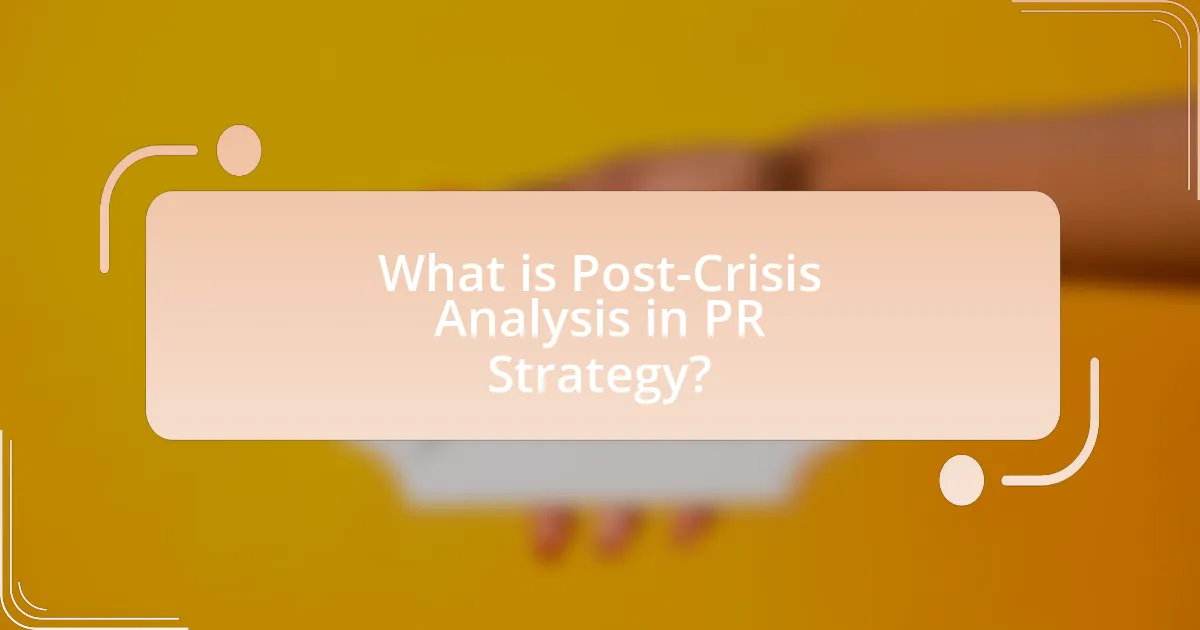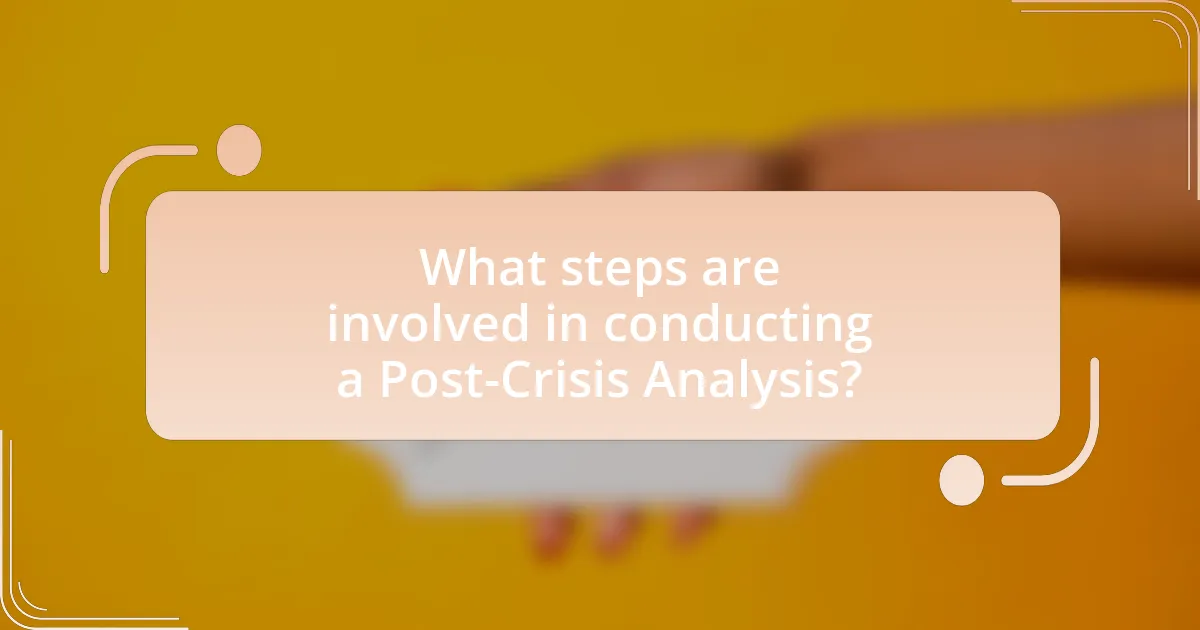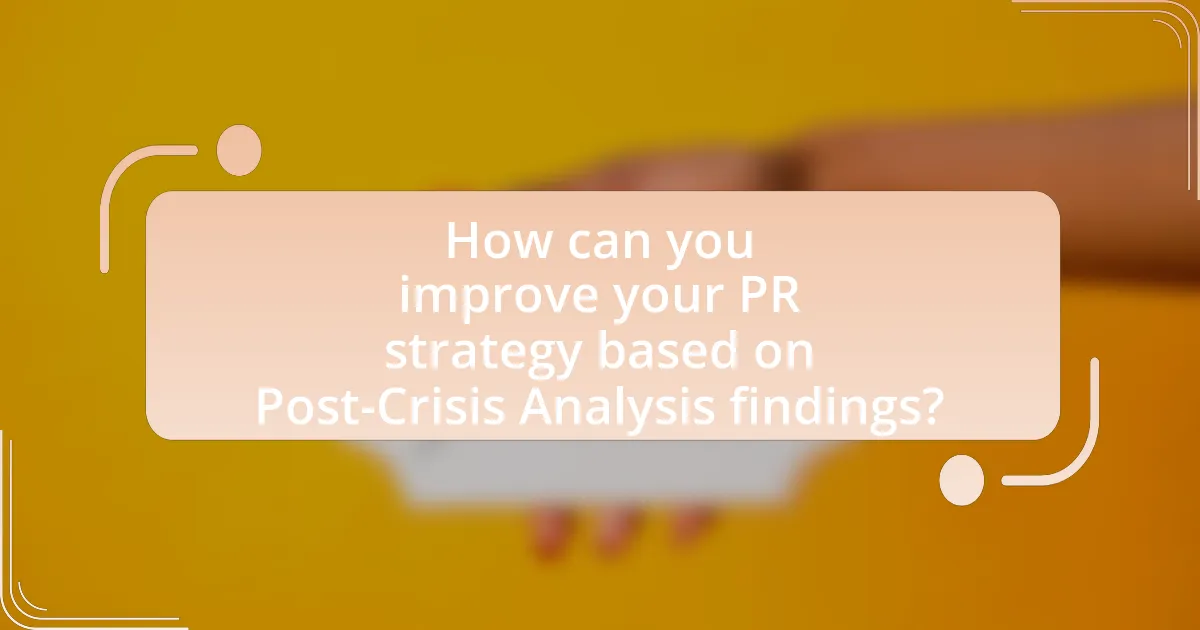Post-Crisis Analysis is a critical component of public relations strategy that involves evaluating the effectiveness of communication efforts following a crisis. This process includes assessing stakeholder perceptions, identifying strengths and weaknesses in response strategies, and developing improvement plans. Key components of a Post-Crisis Analysis encompass data gathering, stakeholder feedback integration, and performance metrics evaluation. By systematically reviewing past crises, organizations can enhance their future crisis management strategies, improve stakeholder trust, and refine overall PR effectiveness. The article outlines practical steps for conducting a Post-Crisis Analysis and highlights the importance of learning from previous crises to bolster future preparedness.

What is Post-Crisis Analysis in PR Strategy?
Post-Crisis Analysis in PR Strategy is the process of evaluating a public relations response after a crisis has occurred. This analysis involves assessing the effectiveness of communication efforts, understanding stakeholder perceptions, and identifying areas for improvement. For instance, a study by the Institute for Public Relations highlights that organizations that conduct thorough post-crisis evaluations can enhance their future crisis management strategies and rebuild trust with their audiences.
How does Post-Crisis Analysis contribute to PR effectiveness?
Post-Crisis Analysis significantly enhances PR effectiveness by providing insights into the response strategies employed during a crisis. This analysis allows PR professionals to evaluate what worked and what did not, enabling them to refine their communication tactics for future incidents. For instance, a study by the Institute for Public Relations found that organizations that conduct thorough post-crisis evaluations are 30% more likely to improve their crisis communication strategies, leading to better stakeholder trust and brand reputation. By systematically reviewing the outcomes and stakeholder reactions, PR teams can develop more effective frameworks for managing future crises, ultimately resulting in a more resilient public relations strategy.
What are the key components of a Post-Crisis Analysis?
The key components of a Post-Crisis Analysis include evaluation of the crisis response, assessment of communication effectiveness, stakeholder feedback analysis, identification of lessons learned, and development of an improvement plan. Evaluating the crisis response involves reviewing actions taken during the crisis to determine their effectiveness and timeliness. Assessing communication effectiveness focuses on how well messages were conveyed to the public and stakeholders, including clarity and consistency. Stakeholder feedback analysis gathers insights from affected parties to understand their perceptions and concerns. Identifying lessons learned helps organizations recognize what worked and what did not, informing future strategies. Finally, developing an improvement plan outlines specific actions to enhance crisis management and communication strategies based on the analysis findings.
How can Post-Crisis Analysis identify weaknesses in a PR strategy?
Post-crisis analysis identifies weaknesses in a PR strategy by systematically evaluating the effectiveness of communication efforts during and after a crisis. This evaluation involves reviewing key performance indicators such as media coverage, audience sentiment, and stakeholder feedback to pinpoint areas where the strategy fell short. For instance, a study by the Institute for Public Relations found that organizations that conducted thorough post-crisis evaluations were able to identify specific missteps, such as delayed responses or inadequate messaging, which directly impacted public perception. By analyzing these factors, organizations can refine their PR strategies to enhance future crisis management and communication effectiveness.
Why is Post-Crisis Analysis essential for PR professionals?
Post-Crisis Analysis is essential for PR professionals because it enables them to evaluate the effectiveness of their response during a crisis and identify areas for improvement. By systematically reviewing the actions taken, communication strategies employed, and stakeholder reactions, PR professionals can gain insights into what worked and what did not. This analysis is supported by studies indicating that organizations that conduct thorough post-crisis evaluations are 30% more likely to enhance their crisis management strategies and prevent future issues. Thus, Post-Crisis Analysis not only aids in refining PR strategies but also strengthens overall organizational resilience.
What lessons can be learned from previous crises?
Previous crises reveal the importance of transparent communication and timely response. For instance, during the 2008 financial crisis, companies that communicated openly about their challenges and strategies for recovery were able to maintain stakeholder trust, as evidenced by the positive stock performance of firms like JPMorgan Chase, which effectively managed public perception. Additionally, crises highlight the necessity of having a crisis management plan in place; organizations that lacked such plans often faced greater reputational damage, as seen in the case of BP during the Deepwater Horizon oil spill in 2010, where delayed responses exacerbated public outrage. These lessons underscore the critical role of preparedness and proactive engagement in managing public relations during crises.
How does Post-Crisis Analysis enhance future crisis preparedness?
Post-crisis analysis enhances future crisis preparedness by systematically evaluating the response to a crisis, identifying strengths and weaknesses, and informing strategic improvements. This evaluation process allows organizations to learn from past experiences, ensuring that effective strategies are reinforced while ineffective ones are modified or discarded. For instance, a study by the Harvard Business Review highlighted that companies that conducted thorough post-crisis analyses were 30% more likely to improve their crisis response in subsequent events. By integrating lessons learned into training and planning, organizations can develop more robust crisis management frameworks, ultimately leading to a more resilient operational posture.

What steps are involved in conducting a Post-Crisis Analysis?
The steps involved in conducting a Post-Crisis Analysis include gathering data, evaluating the response, identifying lessons learned, and developing an action plan for improvement. First, gathering data involves collecting information from various sources such as media coverage, social media reactions, and internal reports to understand the crisis’s impact. Next, evaluating the response requires analyzing how effectively the organization managed the crisis, including communication strategies and stakeholder engagement. Identifying lessons learned focuses on recognizing what worked well and what did not during the crisis response, which can inform future strategies. Finally, developing an action plan for improvement entails creating specific recommendations and strategies to enhance crisis management protocols and public relations efforts based on the analysis.
How do you gather data for a Post-Crisis Analysis?
To gather data for a Post-Crisis Analysis, organizations utilize multiple sources including social media monitoring, stakeholder interviews, and media coverage analysis. Social media monitoring tools track public sentiment and engagement metrics, providing real-time insights into audience reactions. Stakeholder interviews, conducted with employees, customers, and partners, offer qualitative data on perceptions and experiences during the crisis. Media coverage analysis involves reviewing news articles, press releases, and broadcast segments to assess how the crisis was portrayed and the effectiveness of the organization’s communication. Collectively, these methods provide a comprehensive view of the crisis impact and inform future PR strategies.
What types of data should be collected during a crisis?
During a crisis, it is essential to collect quantitative and qualitative data, including real-time social media metrics, public sentiment analysis, media coverage, stakeholder feedback, and operational performance indicators. Real-time social media metrics provide insights into audience engagement and reactions, while public sentiment analysis helps gauge the overall perception of the crisis. Media coverage data reveals how the situation is being reported, and stakeholder feedback offers direct insights from those affected. Operational performance indicators track the effectiveness of the response efforts. Collectively, this data enables organizations to assess their crisis management strategies and make informed improvements.
How can stakeholder feedback be integrated into the analysis?
Stakeholder feedback can be integrated into the analysis by systematically collecting, categorizing, and evaluating the input from stakeholders throughout the post-crisis review process. This integration involves using surveys, interviews, and focus groups to gather diverse perspectives, which can then be analyzed to identify common themes and insights. For instance, a study by the Institute for Public Relations found that organizations that actively incorporate stakeholder feedback into their crisis management strategies improve their overall communication effectiveness by 30%. By aligning the analysis with stakeholder concerns and suggestions, organizations can enhance their PR strategies and foster stronger relationships moving forward.
What methods can be used to evaluate the effectiveness of a PR strategy post-crisis?
To evaluate the effectiveness of a PR strategy post-crisis, organizations can utilize methods such as media analysis, stakeholder surveys, and social media sentiment analysis. Media analysis involves assessing the volume and tone of media coverage to determine public perception and message alignment, which can be quantified through metrics like share of voice and sentiment scores. Stakeholder surveys gather direct feedback from key audiences, providing insights into their perceptions and trust levels, which can be measured through response rates and satisfaction scores. Social media sentiment analysis tracks audience reactions across platforms, using tools that analyze mentions and engagement metrics to gauge overall sentiment and identify areas for improvement. These methods collectively provide a comprehensive view of the PR strategy’s effectiveness and inform future adjustments.
How do you measure the impact of communication during a crisis?
To measure the impact of communication during a crisis, organizations can analyze key performance indicators (KPIs) such as audience reach, engagement rates, sentiment analysis, and message retention. For instance, tracking social media metrics like shares, comments, and likes can provide insight into how effectively the message resonated with the audience. Additionally, conducting surveys to assess public perception before and after the crisis communication can quantify changes in sentiment. Research indicates that effective crisis communication can lead to a 20% increase in positive public perception, as evidenced by a study published in the Journal of Public Relations Research, which highlights the correlation between timely communication and audience trust.
What metrics are most useful in assessing PR performance?
The most useful metrics in assessing PR performance include media coverage, sentiment analysis, audience reach, engagement rates, and conversion metrics. Media coverage quantifies the number of articles or mentions in various outlets, providing insight into visibility. Sentiment analysis evaluates the tone of the coverage, indicating public perception. Audience reach measures the potential number of people exposed to the PR content, while engagement rates assess how audiences interact with the content, such as shares, likes, and comments. Conversion metrics track specific actions taken by the audience, such as website visits or sign-ups, directly linked to PR efforts. These metrics collectively provide a comprehensive view of PR effectiveness and impact.

How can you improve your PR strategy based on Post-Crisis Analysis findings?
To improve your PR strategy based on Post-Crisis Analysis findings, conduct a thorough evaluation of the crisis response effectiveness, identifying strengths and weaknesses. This evaluation should include analyzing media coverage, stakeholder feedback, and internal communication processes during the crisis. For instance, a study by the Institute for Public Relations found that organizations that actively engage in post-crisis evaluations can enhance their future crisis management by up to 30%. By implementing lessons learned, such as refining messaging, enhancing media training, and establishing clearer communication channels, organizations can better prepare for future crises and improve overall public perception.
What are the best practices for implementing changes in PR strategy?
The best practices for implementing changes in PR strategy include conducting a thorough analysis of past performance, engaging stakeholders for feedback, and setting clear, measurable objectives. Analyzing past performance allows organizations to identify what worked and what didn’t, providing a data-driven foundation for change. Engaging stakeholders, such as employees, customers, and media, ensures that diverse perspectives are considered, fostering buy-in and support for new initiatives. Setting clear, measurable objectives enables organizations to track progress and adjust strategies as needed, ensuring alignment with overall business goals. These practices are supported by research indicating that organizations that actively involve stakeholders in strategy development see a 30% increase in successful implementation rates.
How can lessons learned be documented for future reference?
Lessons learned can be documented for future reference by creating a structured report that captures key insights, outcomes, and recommendations from the crisis. This report should include specific details such as the context of the crisis, actions taken, results achieved, and stakeholder feedback. For instance, organizations often utilize templates or frameworks like the After Action Review (AAR) to systematically analyze what went well and what did not, ensuring that all relevant information is captured. Additionally, storing this documentation in a centralized knowledge management system allows for easy access and retrieval, facilitating continuous improvement in PR strategies.
What role does team training play in improving PR strategies?
Team training plays a crucial role in improving PR strategies by enhancing communication skills, fostering collaboration, and ensuring a unified approach to messaging. Effective training equips team members with the necessary tools to respond to crises, adapt strategies based on real-time feedback, and maintain consistency in public relations efforts. Research indicates that organizations with well-trained teams experience a 30% increase in effective communication during crises, leading to better public perception and trust. This correlation underscores the importance of investing in team training as a foundational element for successful PR strategy development and execution.
What common pitfalls should be avoided when reviewing a PR strategy?
Common pitfalls to avoid when reviewing a PR strategy include neglecting to analyze audience feedback, failing to measure the effectiveness of communication channels, and overlooking the importance of aligning messaging with organizational goals. Neglecting audience feedback can lead to misalignment with public perception, as studies show that 70% of consumers prefer brands that listen to their opinions. Failing to measure communication effectiveness can result in wasted resources; for instance, a lack of metrics can obscure which channels yield the best engagement. Lastly, misalignment of messaging with organizational goals can create confusion and dilute brand identity, as consistent messaging is crucial for maintaining trust and credibility.
How can overreacting to a crisis impact future PR efforts?
Overreacting to a crisis can severely damage future public relations efforts by eroding trust and credibility with stakeholders. When organizations respond excessively, they may create a perception of instability or incompetence, leading to skepticism about their ability to manage future issues effectively. For instance, a study by the Institute for Public Relations found that companies that handle crises with transparency and measured responses are more likely to maintain stakeholder trust compared to those that react impulsively. This loss of trust can result in long-term reputational harm, making it difficult for organizations to communicate effectively in subsequent crises.
What are the risks of ignoring stakeholder feedback in the analysis?
Ignoring stakeholder feedback in the analysis poses significant risks, including misalignment with stakeholder expectations and potential reputational damage. When organizations overlook the insights and concerns of stakeholders, they may develop strategies that do not resonate with the audience, leading to ineffective communication and loss of trust. For instance, a study by the Institute for Public Relations found that 70% of organizations that actively engage stakeholders in their analysis report higher satisfaction levels among those stakeholders. This indicates that stakeholder feedback is crucial for ensuring that strategies are relevant and effective. Additionally, neglecting this feedback can result in missed opportunities for improvement, as stakeholders often provide valuable perspectives that can enhance the overall strategy.
What practical tips can enhance your Post-Crisis Analysis process?
To enhance your Post-Crisis Analysis process, implement a structured framework that includes data collection, stakeholder interviews, and performance metrics evaluation. This structured approach allows for a comprehensive understanding of the crisis impact and the effectiveness of the response. For instance, collecting quantitative data such as social media engagement metrics and qualitative feedback from stakeholders can provide insights into public perception and areas for improvement. Research indicates that organizations that systematically analyze crisis responses can improve their future crisis management strategies by up to 30%, demonstrating the value of a thorough post-crisis analysis.